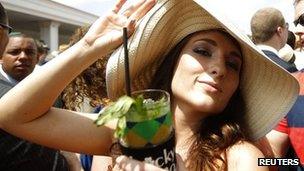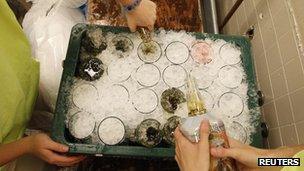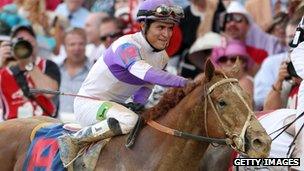Is the Kentucky Derby still decadent and depraved?
- Published
In 1970, Hunter S Thompson wrote The Kentucky Derby Is Decadent and Depraved, his seminal article about America's most celebrated horse race. The writer's first piece of gonzo journalism, it was a vivid sketch of the event's drunken debauchery. Four decades on, has much changed?

The Kentucky Derby is at least as famous for what goes on off the track as on it
The sun is barely over the yardarm at Louisville's race course, but the notorious infield is already looking not dissimilar to the "sea of drunken horrors" and "huge outdoor loony bin" depicted by Thompson all those years ago.
Given that Churchill Downs opens for business at 08:00 on Kentucky Derby day, it is little surprise to find over-refreshed punters staggering about in the noon sunshine as though buffeted by hurricane-force winds.
In the whole of North America, it is said that only New Orleans during Mardi Gras can match the party atmosphere of the Kentucky Derby.
Jennie Rees, turf writer for Louisville's Courier-Journal newspaper, says: "The Derby is a real slice of Americana. The only thing I think we don't have from you guys [in the UK] is the gypsies - no gypsies in the infield. But we do have a lot of raucous revellers."
Some of the antics at Churchill Downs would make Aintree in its pomp look as tame as a maiden aunt's cribbage luncheon.
When Thompson wrote his famous article about the Derby, he was not interested in the actual race.
As the gonzo writer himself put it: "We didn't give a hoot in hell what was happening on the track. We had come there to watch the real beasts perform."
He would no doubt find today's infield - a carnival of half-naked humanity basting under an apricot sun - familiar.
Bare-chested men juiced up on bourbon wrestle in a mire of mud, while amorous couples roll in the grass. Young women - hoisted aloft like trophies by sombrero-wearing college quarterbacks - expose their breasts, prompting a chorus of hoots from male admirers.
The scene evokes a sumptuous tableau of bacchanalian misrule painted by the baroque master Rubens.
By late afternoon senseless bodies are strewn everywhere like fallen combatants from some mighty battle.
Why do 160,000 or so punters travel every year from across the United States to watch a horse race that lasts barely 120 seconds?
It is because this meeting is known as the most exciting two minutes in sport.
Stud fees
Set up in 1875 to emulate England's Epsom Derby, it is America's oldest continual sporting event.
Steeped in tradition and pageantry, this is the race every horse-owner wants to win.
The one-and-a-quarter mile (2km) taut oval course is only open to three-year-old thoroughbreds that have never run it before.
The victorious owner trots off with most of a $2m (£1.2m) purse, and an offer to sell his horse to a stud farm for up to $1m (£619k) a day.
Little wonder the floral blanket draped over the winning horse's withers, for which the race is known as the Run for the Roses, is so prized.
Churchill Downs' track announcer, Mark Johnson, who comes from Skegness, Lincolnshire, believes the Derby is "without a shadow of a doubt" more important than the two legs of the Triple Crown which follow (the Preakness Stakes in Baltimore, Maryland, at the end of May and June's Belmont Stakes in Elmont, New York).
"The Kentucky Derby transcends sport," he says. "All humanity is there. It's probably a little more Royal Ascot than Grand National.

The mint julep is a much cherished Kentucky Derby tradition
"It involves high society and high sport and high stakes. But if you want to make it a debauched party you can. The infield is more like Woodstock than a race meeting."
Thoroughbreds and prodigies
If the infield specimens could be compared to wild mustangs prancing in the prairie dust, then those up on Millionaires' Row are pampered like human thoroughbreds.
In this hermetically sealed, air-conditioned oasis strut the seersucker suit-wearing aristocrats of Derby day.
A seat among these celebrities, socialites and cigar-chomping captains of commerce can cost up to $8,000 (£4,900).
Leggy Southern belles glide in a cirrocumulus of perfume, with the grace of pedigree race horses, through this elite club.
Glossy manes of hair tumble down their sun-kissed backs, beneath cartwheel-sized hats.
These prodigies of millinery - adorned with tulle, feathers and flowers - are one of the most cherished traditions of the annual Kentucky swill.
Many of the punters are liberally indulging in another hallowed Derby custom: the mint julep, a beverage of bourbon, sugar syrup, bruised mint leaves and shaved ice served in a highball glass.
For those abstemious enough to remain on their feet until the big race, they are unlikely ever to forget the experience.
From the derby winner's circle a bugler dressed like a master of foxhounds sounds the Call to the Post.
As 20 majestic horses are led to the starting gate by outriders, Churchill Downs twitches with anticipation.
Kentucky - the home of bluegrass and bourbon, Abraham Lincoln, Muhammad Ali and, last but not least, Colonel Sanders - is a proud commonwealth.
So when a marching band strikes up the state song, My Old Kentucky Home (a plantation slave lament), grown men choke back tears.
A reverent hush descends across the field as the fired-up horses bounce in their stalls, impatient to get to work.
The bell trills, and the cavalry charge begins.
Over the track spurt the mounts, like jets of liquid crystal - it is a living sonnet to motion.

Mario Gutierrez rode I'll Have Another to victory at this year's Derby
Down the homestretch, I'll Have Another erupts like a flaming meteor from a storm cloud of horseflesh and hurtles down the final furlong to victory.
As the chestnut colt flies over the finish line, the crowd's roar consumes Churchill Downs with the fury of a tempest.
The Kentucky Derby is over, but its spell lingers long in the air, like the smell of sulphur from fireworks.
It is true that this epic race meeting still offers decadence and depravity in abundance.
But it has much more than that. Another famous American author who immortalised the event in prose expresses it well.
In 1956 John Steinbeck wrote: "The Kentucky Derby, whatever it is - a race, an emotion, a turbulence, an explosion - is one of the most beautiful and violent and satisfying things I have ever experienced."